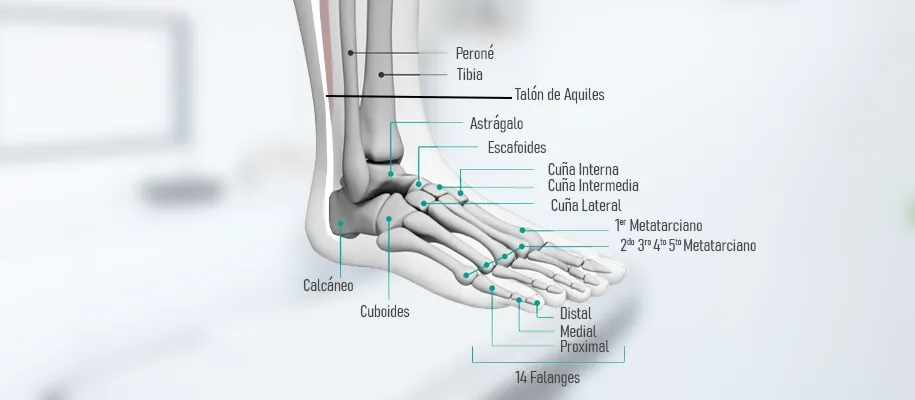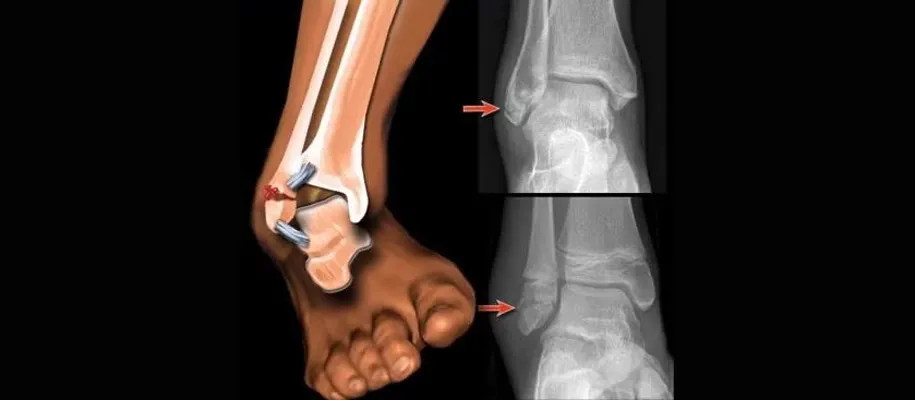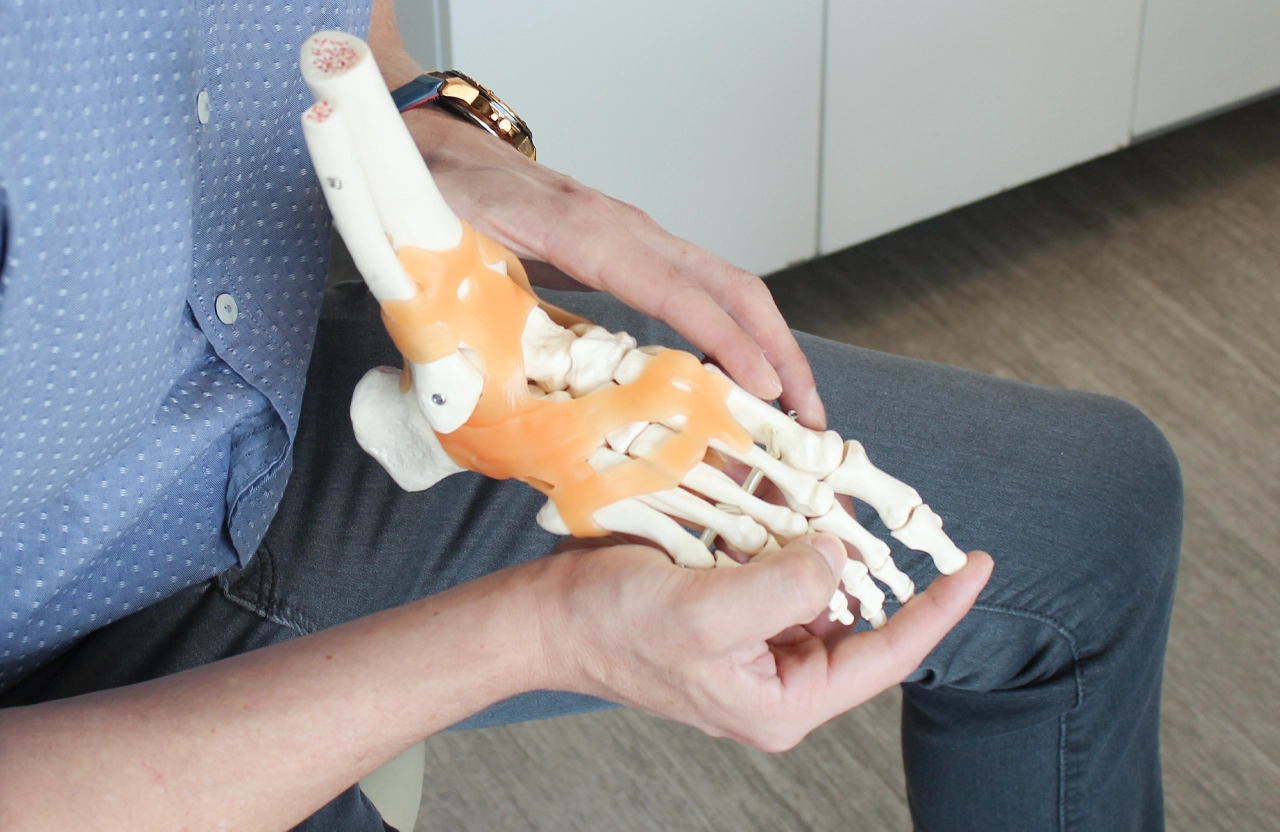One of the most common and also most complex injuries in trauma consultations are ankle fractures.
They affect multiple structures: bones, ligaments (which maintain joint alignment), nerves and blood vessels, and can become more complicated with more fractured bones due to increased instability.
This is because your ankle functions like a well-adjusted door hinge. It only moves in two planes: upward (dorsiflexion) and downward (plantar flexion). For this hinge to work smoothly and stably, it depends on three key bones that fit together perfectly: the distal end of the tibia (shinbone), the fibula (the thinner leg bone), and the talus (the bone that connects to the foot).
Ankle Structure: What Provides Support and Stability?
The "Cup" of Support:
The ends of the tibia and fibula create a sort of cup into which the top of the talus (an irregularly shaped bone connecting the foot to the leg) fits, like a puzzle piece.
The "Pillars" of Stability:
This structure is reinforced by three bony prominences known as malleoli:
- Medial Malleolus: Part of the tibia (inner ankle).
- Posterior Malleolus: Also part of the tibia (back of ankle).
- Lateral Malleolus: Part of the fibula (outer ankle).
When one or more of these pillars fracture, the structure loses stability and alignment precision.
These are the most common symptoms of an ankle fracture
- Intense pain when putting weight on the foot or applying pressure
- Swelling, bruising and numbness
- Functional limitation (difficulty walking)
- Visible deformity in displaced fractures

Types of ankle fractures by shape and location
By shape:
- Hairline (crack without displacement)
- Simple (linear break)
- Displaced (separated fragments)
- Comminuted (multiple fragments)
- Open (bone exposed)
By location:
- Medial malleolus: Fracture of the inner tibia. If not displaced or fragments are small, may be treated without surgery.
- Posterior malleolus: Fracture at the back of the tibia. If affecting >25% of joint, requires surgery due to instability.
- Bimalleolar: Fracture of two malleoli.
- Bimalleolar equivalent: Fracture of one malleolus with medial ligament injury (e.g. deltoid ligament rupture). Both are unstable and usually require surgery.
- Trimalleolar: Fracture of all three malleoli. Always unstable and requires surgery.
When NOT to operate an ankle fracture?
Each patient is different and factors like age and fracture type will determine if conservative treatment is appropriate, such as for stable fractures (non-displaced infrasyndesmotic and transsyndesmotic fibular fractures without medial injury) which may be treated without surgery.
Conservative treatment involves immobilization with a cast boot with the ankle at a 90° angle for 4-6 weeks. This positioning helps prevent contractures. During this period, partial weight bearing may be allowed, followed by rehabilitation to recover mobility and strength.
When SHOULD you operate an ankle fracture?
Surgery is indicated if there is bone displacement, if it compromises joint stability, if there are injuries in other areas, or if there are multiple fragments requiring plates or grafts for reconstruction. The MIPO technique involves placing plates with minimal skin opening. For very complex cases, we sometimes place an external fixator to allow space for the fragments to align.

How is surgery chosen for your ankle fracture? Key factors
If you've been told you need surgery for your ankle fracture, you may wonder what type of operation is best for you. The answer: it depends.
The surgical approach to repair an ankle fracture isn't one-size-fits-all. The decision about which technique to use (like plates, screws, or even joint fusion or replacement in advanced cases) depends on you and your specific injury.
Orthopedic trauma surgeons evaluate several key aspects:
- Your overall health: Do you have other conditions?
- Your age
- Fracture severity: How many fragments are there? Is it displaced? Are ligaments damaged?
- Your lifestyle and activity level: Are you very active, an athlete, or more sedentary?
If the fracture has caused severe damage to the ankle joint, affecting much of the cartilage, options may include arthrodesis (fusing bones to eliminate pain) or arthroplasty (replacing the damaged joint with a prosthesis).
Types of surgical approaches
- Anterolateral Approach: Used for fibula and distal tibia fractures, as well as for accessing the tibiotalar joint. Allows good visualization of the articular surface and application of submuscular and subcutaneous plates.
- Posterolateral Approach: Used for posterior malleolus and syndesmosis fractures. Provides good visualization of the posterior fragment and facilitates anatomical reduction and stable fixation, including the syndesmosis.
- Medial Approach: Used for medial malleolus and distal tibia fractures, including approaches for medial malleolus fracture repair and syndesmosis.
- Combined Anterolateral and Medial Approach: Used in complex fractures involving both lateral and medial aspects of the ankle.
Key Recovery Tips After Ankle Surgery
Physical therapy is essential to recover mobility, balance and muscle strength after ankle surgery. Always follow the personalized plan designed by your physical therapist, as well as attending follow-up appointments with your orthopedic surgeon to monitor fracture progress.
Listen carefully to your body: exercise progression should be gradual and intensity should only increase if pain allows; never force recovery, as pain is an important signal.
Once past the initial rehabilitation phase, you can begin incorporating low-impact activities like stationary biking, swimming or walking on flat surfaces, always with prior authorization.
Frequently Asked Questions
How long until I can walk again?
The answer varies significantly for each person, as every body and every fracture is unique, and recovery time depends on the type of injury and its treatment. Generally, you can begin weight bearing and taking first steps with crutches or a walker between 6-12 weeks post-surgery.
To support this process and promote faster, stronger recovery, your best ally is self-care: with a diet rich in proteins, vitamins and minerals to repair bone and muscle health, complemented with supplements. It's important to improve habits and completely avoid tobacco, alcohol, excessive coffee and energy drinks as these substances can interfere with healing and consolidation.
How to sleep with an ankle fracture?
- On your back with foot elevated: Sleeping on your back is one of the most recommended positions. Elevating the ankle reduces fluid accumulation, minimizing swelling.
- Firm but comfortable pillows: Use cushions that keep the foot elevated slightly above heart level. This promotes lymphatic drainage and reduces swelling.
- Strategic placement: Place one pillow under the injured ankle and another under the leg to avoid tension.
- Avoid overly soft cushions: They don't provide necessary support and may leave the ankle in an uncomfortable position overnight.
What are the most common complications of an ankle fracture?
- Delayed consolidation: Does not heal within 3 months. Interested in learning more about complications such as pseudarthrosis? Continue exploring the blog.
- Joint stiffness: Usually due to lack of mobility and rehabilitation exercises
- Infections: Depends on each patient and infection degree - may require antibiotics or surgical intervention
- Poor stability: If a fracture heals in incorrect position it will cause incorrect functionality, generating pain and wear requiring revision surgery
- Post-traumatic arthritis: In some patients fractures can accelerate joint degeneration requiring intervention like joint fusion or arthroplasty
Your recovery requires attention and conscious action: always listen to your body and don't hesitate to ask your orthopedic surgeon all your questions about the injury, treatment or recommendations. Each case is evaluated comprehensively to ensure the best possible outcome.
Do you need specialized evaluation?
If you're seeking a second opinion, a family member had an accident, or you need guidance. I offer remote medical consultations for your convenience, or you can visit me at my office in Torre Norte 2, Tijuana - an accessible building with parking and spacious, comfortable facilities so you have no difficulty receiving care.
No hay comentarios para este blog.
